Mount Wutai
Mount Wutai, also known by its Chinese name Wutaishan and as Mount Qingliang, is a sacred Buddhist site at the headwaters of the Qingshui in Shanxi Province, China. Its central area is surrounded by a cluster of flat-topped peaks roughly corresponding to the cardinal directions. The north peak (Beitai Ding or Yedou Feng) is the highest (3,061 m or 10,043 ft) and is also the highest point in northern China.
| Mount Wutai | |
|---|---|
| 五台山 | |
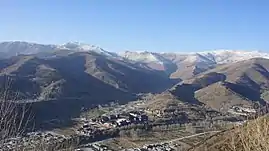 Mount Wutai from the air | |
| Highest point | |
| Elevation | 3,061 m (10,043 ft) |
| Coordinates | 39°04′45″N 113°33′53″E |
| Geography | |
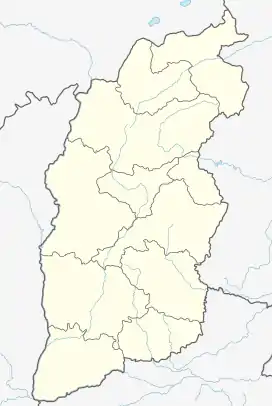 Mount Wutai Wutai County, Shanxi, China | |
| Climbing | |
| Easiest route | Hike |
| Criteria | Cultural: ii, iii, iv, vi |
| Reference | 1279 |
| Inscription | 2009 (33rd session) |
| Area | 18,415 ha |
| Buffer zone | 42,312 ha |
| Mount Wutai | |||||||||||||||||||||||||||||
|---|---|---|---|---|---|---|---|---|---|---|---|---|---|---|---|---|---|---|---|---|---|---|---|---|---|---|---|---|---|
| Chinese | 五台山 | ||||||||||||||||||||||||||||
| Literal meaning | "Five-Terrace Mountain" | ||||||||||||||||||||||||||||
| |||||||||||||||||||||||||||||
As host to over 53 sacred monasteries, Mount Wutai is home to many of China's most important monasteries and temples. It was inscribed as a UNESCO World Heritage Site in 2009[1] and named a AAAAA tourist attraction by China's National Tourism Administration in 2007.
Significance
Mount Wutai is one of the Four Sacred Mountains in Chinese Buddhism. Each of the mountains is viewed as the bodhimaṇḍa (道場; dàocháng) of one of the four great bodhisattvas. Wǔtái is the home of the Bodhisattva of wisdom, Mañjuśrī or "文殊" (Wénshū) in Chinese. Mañjuśrī has been associated with Mount Wutai since ancient times. Paul Williams writes:[2]
Apparently the association of Mañjuśrī with Wutai (Wu-t'ai) Shan in north China was known in classical times in India itself, identified by Chinese scholars with the mountain in the 'north-east' (when seen from India or Central Asia) referred to as the abode of Mañjuśrī in the Avataṃsaka Sūtra. There are said to have been pilgrimages from India and other Asian countries to Wutai Shan by the seventh century.
Wutai was the first of the mountains to be identified and is often referred to as "first among the four great mountains". It was identified on the basis of a passage in the Avataṃsaka Sūtra, which describes the abodes of many bodhisattvas. In this chapter, Mañjuśrī is said to reside on a "clear cold mountain" in the northeast. This served as charter for the mountain's identity and its alternate name "Clear Cool Mountain" (清涼山; Qīngliáng Shān).
The bodhisattva is believed to frequently appear on the mountain, taking the form of ordinary pilgrims, monks, or most often unusual five-colored clouds.
Reflecting regional rivalries between Buddhist centers, 9th-century Chan Buddhism master Linji Yixuan criticized the prominence of Wutai in Tang dynasty China. According to the posthumously compiled Línjì yǔlù, Linji Yixuan once said, “There‘s a bunch of students who seek Mañjuśrī on Mount Wutai. Wrong from the start! There‘s no Mañjuśrī on Mount Wutai.“ His campaign was however not successful, and even after the Tang era Mount Wutai “continued to thrive as perhaps the single most famous Buddhist sacred site in China.”[3]
Mount Wutai has an enduring relationship with Tibetan Buddhism.[4]
Mount Wutai is home to some of the oldest wooden buildings in China that have survived since the era of the Tang Dynasty (618–907). This includes the main hall of Nanchan Temple and the East Hall of Foguang Temple, built in 782 and 857, respectively. They were discovered in 1937 and 1938 by a team of architectural historians including the prominent early 20th-century historian Liang Sicheng. The architectural designs of these buildings have since been studied by leading sinologists and experts in traditional Chinese architecture, such as Nancy Steinhardt. Steinhardt classified these buildings according to the hall types featured in the Yingzao Fashi Chinese building manual written in the 12th century.
In 2008, there were complaints from local residents that, in preparation for Mount Wutai's bid to become a UNESCO World Heritage Site, they were forced from their homes and relocated away from their livelihoods.[5]
Major temples
Nanshan Temple (Chinese: 南山寺) 38.9815°N 113.5738°E is a large temple in Mount Wǔtái, first built in the Yuan Dynasty. The whole temple comprises seven terraces, divided into three parts. The lower three terraces are named Jile Temple (極樂寺); the middle terrace is called Shande Hall (善德堂); the upper three terraces are named Youguo Temple (佑國寺). Other major temples include Xiantong Temple, Tayuan Temple and Pusading Temple.
Other important temples inside Mount Wutai include Shouning Temple, Bishan Temple, Puhua Temple, Dailuo Ding, Qixian Temple, Shifang Tang, Shuxiang Temple, Guangzong Temple, Youguo Temple, Guanyin Dong, Longhua Temple, Luomuhou Temple, Jinge Temple, Zhanshan Temple, Wanfo Ge, Guanhai Temple, Zhulin Temple, Jifu Temple, and Gufo Temple.
Outer Mount Wutai temples include Yanqing Temple, Nanchan Temple, Mimi Temple, Foguang Temple, Yanshan Temple, Zunsheng Temple, and Guangji Temple. A giant statue of Maha Manjushree was presented to the Buddhists of China by foreign minister of Nepal Ramesh Nath Pandey in 2005.
Transportation
The Wutaishan Airport in nearby Dingxiang County opened in December 2015.[6][7]
Gallery
 The Xiantong Temple, a major temple at Mount Wutai
The Xiantong Temple, a major temple at Mount Wutai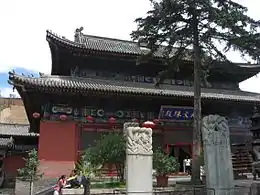 A palace hall at Mount Wutai
A palace hall at Mount Wutai The Dailuoding Temple
The Dailuoding Temple The Lingfeng Temple pagoda
The Lingfeng Temple pagoda The Sarira Stupa of Tayuan Temple, built in 1582 during the Ming Dynasty
The Sarira Stupa of Tayuan Temple, built in 1582 during the Ming Dynasty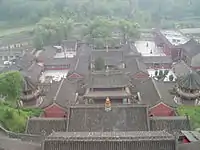 View of the Zunsheng Temple
View of the Zunsheng Temple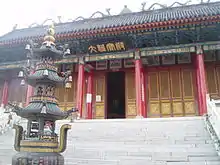 Qifo Temple
Qifo Temple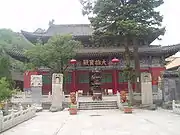 Yuanzhao Temple
Yuanzhao Temple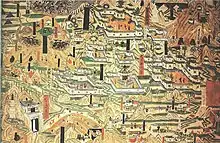 10th century mural of Mount Wutai. From Cave 61 of Mogao Caves in Dunhuang
10th century mural of Mount Wutai. From Cave 61 of Mogao Caves in Dunhuang 1846, Qing Dynasty map of Mount Wutai
1846, Qing Dynasty map of Mount Wutai
References
- China’s sacred Buddhist Mount Wutai inscribed on UNESCO’s World Heritage List. UNESCO World Heritage Centre
- Williams, Paul. Mahayana Buddhism: The Doctrinal Foundations. 2000. p. 227
- Keyworth, George A. (2019). "How the Mount Wutai cult stimulated the development of Chinese Chan in southern China at Qingliang monasteries". Studies in Chinese Religions. 5 (3–4): 353–376. doi:10.1080/23729988.2019.1686872. S2CID 213258968.
- Tuttle, Gray (2006). 'Tibetan Buddhism at Ri bo rtse lnga/Wutai shan in Modern Times.' Journal of the International Association of Tibetan Studies, no. 2 (August 2006): 1-35. Source: (accessed: Monday, July 1, 2013)
- "五台山机场建设工程全面加速". Shanxi Ribao. 2014-07-04.
- "山西五台山机场正式通航". Xinhua.net. 2015-12-29.
Further reading
- China's Holy Mountain: An Illustrated Journey into the Heart of Buddhism by Christoph Baumer. I.B. Tauris, London 2011. ISBN 978-1-84885-700-1.
- Isabelle Charleux (29 June 2015). Nomads on Pilgrimage: Mongols on Wutaishan (China), 1800-1940. BRILL. ISBN 978-90-04-29778-4.
- http://www.thlib.org/collections/texts/jiats/#!jiats=/06/elverskog/b2/
External links
| Wikimedia Commons has media related to Mount Wutai. |
| Wikivoyage has a travel guide for Mount Wutai. |
